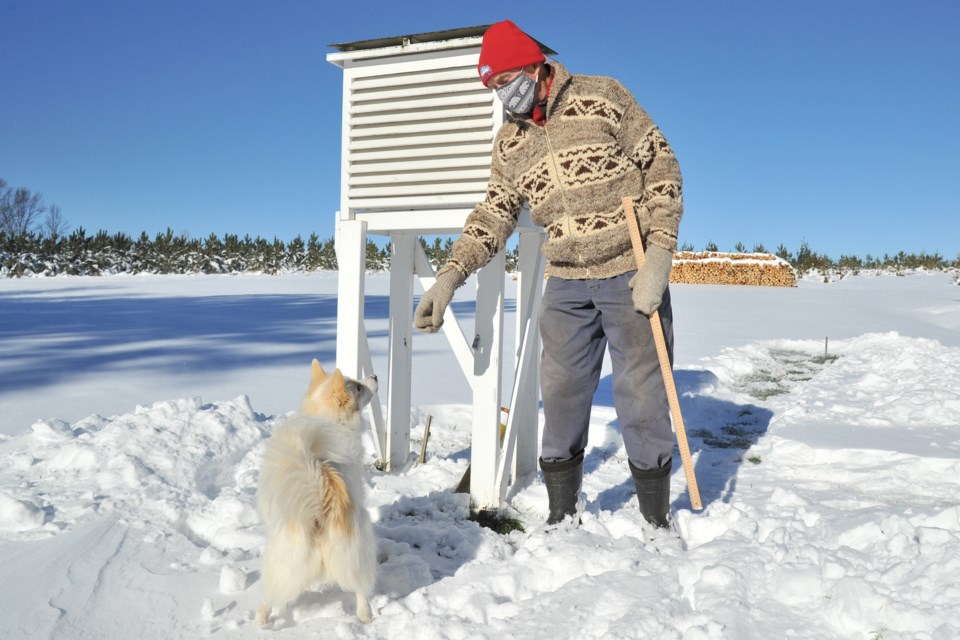Winter has always had plenty of tricks up her sleeve.
But temperature swings and changing weather patterns of late (think decades) may have made what some folks call an "old-fashioned winter" a thing of the past.
Or at least not as frequent.
For one thing, it never used to rain so much in the winter time as it does these days, says John Dunsmore, who has been collecting climatic data for Environment Canada since 1973 on his farm just outside Barrie on Ridge Road.
“What I’ve noticed over the last number of winters is that I’ve never been able to bring in my rain gauge and put it away,” he tells BarrieToday while walking to the two-metre-tall weather station on his property. “Every week I would have it out. I had it out last night (Monday); a bit unusual for the end of November.”
Back in the day, however, it wasn’t unusual to see drifts as tall as houses, or higher, he says.
“Up here on the end of Grove Street and Penetanguishene Road, the snow was right up to the telephone wires. Mind you, the wires were lower then than they are now, but when we were kids we could touch the telephone wires.”
Fifty years ago, it was quite common to have two feet of snow on the ground at any one time throughout the entire winter, Dunsmore says.
“A lot of the streets were covered with snow all winter. They were packed (down)," he says.
“The township out where we lived wouldn’t plow the roads on the weekend. They would generally try to have it plowed by Monday morning,” Dunsmore adds. “When I was in my early teens in the late '40s, one time Highway 11 and 93 were plugged for about a week with snow. Another winter, what is now Georgian Drive was plugged all winter with drifted snow and the township didn’t clear it out until the spring came.”
That type of snow removal service wouldn’t cut it for Barrie residents today, however.
Craig Morton, the city’s manager of roads, stormwater and rail operations, says much has changed in the past five decades, both in the technology for snow removal and residents’ expectations.
“Winter maintenance was historically an all-hands-on-deck approach, getting operators into equipment and addressing heavily travelled areas first, and working long hours until the job was completed,” Morton says. “Many municipalities cleared roads only and did not clear sidewalks.
“Over the years, the task of winter maintenance has evolved to a more precise and co-ordinated operation that meets regulations for levels of service and environmental guidelines for controlling salt usage to protect the environment,” he says, adding Barrie has experienced “unprecedented growth” over the past 50 years — there were 26,684 people in 1970 and in 2019 there were 149,964 — resulting in a larger and more diversified fleet of equipment and technology to address changing needs.
“Also, climate change has resulted in more frequent freeze/thaw and ice storm events,” Morton adds.
That’s not news to Dunsmore, who speculates that a wandering jet stream, miles above the Earth, is becoming more erratic (no doubt due to human activity, he says), allowing more incidents of warm Gulf of Mexico air masses making their way to southern Ontario, and keeping his rain gauge out of storage.
“The prevailing winds used to be from the northwest and now, to me, those winds seem to be coming more from the south or the southwest (with the accompanying moisture),” he says.
Longtime Barrie resident Deb Exel says that while she doesn’t recall having a ‘snow day’ way back when, most years the snow would fall earlier and stay longer than today.
“But I was also close enough to walk to and from school and home for lunch every day, regardless of the weather,” says Exel, adding the white stuff used to really accumulate.
“As a kid, after a big snowfall, those astonishingly high piles of snow were a magnet: sliding down the towering banks or tunnelling in them, creating forts,” she adds.
“We also walked to the golf course (what is now Sunnidale Park) to go sledding and would stay for hours… flying down the hill, sometimes landing in the creek at the bottom. Most of us had huge wooden toboggans that weighed a ton or aluminum flying saucers!”
Give Dunsmore an old-time winter any time, he says.
“I enjoyed it a lot more. We used to wear moccasins to public school in the '40s. Everything was frozen and cold, but you could wear them and stay warm. But not now, it’s too wet. (Shopkeeper) Charlie O’Connor in Barrie sold them,” he says. “There was more snow and more cold weather. It stayed cold.
“We like a good cold winter. My ancestors came from northern Scotland and we’ve never felt the need to go south.”



